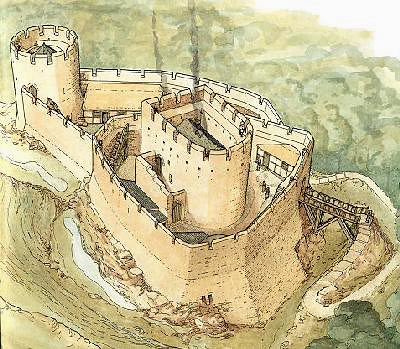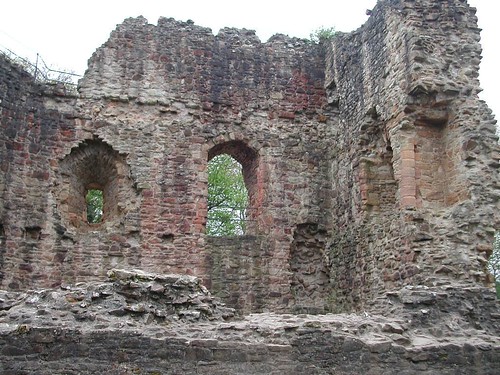Ewloe Castle

Ewloe, Hawarden, Flintshire
Type: motte
Ewloe Castle Converted to stone by Llywelyn the Great. A D-shaped great tower sat in the upper bailey.
Ewloe Castle lies hidden in woodland. It is an extraordinary Welsh stone keep and bailey castle, founded by Prince Llewelyn ap Gruffydd. It may have been built around 1150 by Owain Gwynedd, Prince of all Wales, but was converted to stone in about 1210 by Llywelyn the Great. The upper bailey has part of its curtain wall and the remains of a D-shaped two-storey keep and the steps of a forebuilding. The lower bailey again has part of its curtain wall, the well and the remains of a two-storey round tower at the far end. Extensive earthworks and rock-cut ditches complete its defence but this sloping site, is tactically a puzzle.
No gate connects the courtyards, both were entered from the north side outside the castle. The communication was only at parapet level. Also the two curtains are not bonded together, they are the result of successive building campaigns. Nothing stands of the inside buildings, which were of timber.

A Welsh castle dating from 1146. The tower was added in 1210 and the curtain wall in 1257. It was abandoned at the end of the 13th century. 6 miles north-west is Flint Castle and 3 miles south-east is Hawarden Castle.
Great part of the keep is collapsed, but the south front still stands to full height. The tower contained a single apartment above a storage chamber, reachable only through a trapdoor. The outer walls rose higher than the two storeys to protect the roof from burning projectiles. On the parapet slots for a hoarding are still visible.

All of us carry within us an image of a castle. Without doubt the fairy-tale image of castle takes root in our imagination early; it is a myth that has been created in the past, over a long period of time. The creation of an image of the classic feudal castle in art began long before these castles became redundant during the period in which the nobility moved down to the plains and when political, social, and economic activity became concentrated in the towns. With this change, hilltop castles became part of the landscape backgrounds in prints and paintings.
The castle, perched on vertiginous crags of impossible heights, became a decorative feature. Only the nineteenth-century Bavarian castles of Ludwig II have more towers and pinnacles. The architectural forms of a castle were already exaggerated in the late medieval period, which revelled in a desire to reach ever higher, using increasingly slender and pointed elements.
From the seventeenth century, depictions of ruins become increasingly common. The castle comes to be resonant with symbolism and fairy-tale attributes. Castles and towers came to be represented in drawings, paintings and prints. Tableware, porcelain, and fabrics were decorated with images of romantic ruins -- which themselves became models for architecture.
After the Baroque period, neo-Gothic aristocratic residences were constructed in the form of castles. Moreover, starting from existing small ruins in their grounds, entire new ruined castles came to be built, becoming ever greater in scale. Thus in the nineteenth century an insignificant artistic phenomenon --- representation of castles, developed into a trend that was to become a dominant architectural style.
Castles in Europe evolved from the first wooden forts made to lodge a garrison to spectacular stone structures able to support a small army for extended times. Each country in Europe developed its own architectural designs copying from that of the castles in other countries.
The race to build castles as the best military defenses, turned into a competition for the most magnificent architectural designs in the world.
Labels: Castles in Europe, Medieval Castles Dream







0 Comments:
Post a Comment
<< Home